Spathi, Maria. "The sanctuary of Artemis Limnatis in ancient Messene: An overview of the finds assemblage." CHS Research Bulletin 11 (2023). https://nrs.harvard.edu/URN-3:HLNC.ESSAY:103377753
Early Career Material Culture Fellow in Hellenic Studies 2022-23
Artemis was a particularly beloved goddess, not just in the ancient city of Messene but also throughout the entire Peloponnese. Most of her sanctuaries were located outside the cities in places that demarcated the borders between regions, often near natural water sources and with a special relationship with the natural environment.1 In the city of Messene, Pausanias mentions the statues made by Damophon of Artemis Phosphoros (IV, 31.10) and Artemis Laphria (IV, 31.10), while inscriptions attest to the worship of Artemis Limnatis and Orthia, whose sanctuaries have been securely identified and excavated. Two more votive inscriptions with invocations to Artemis Enodia and Soteira, from the 3rd century BC2 have also come to light.
While the sanctuary of Artemis Orthia was located in the center of the city,3 that of Artemis Limnatis was founded on the outskirts, on the south slope of Mount Ithome but still within the vast city walls [fig. 1]. It is situated on a natural rocky spur, approximately 500 m above sea level, and is sited 800 m from the city agora and 600 m from the Laconian Gate, the main entrance to the city from the east. It was discovered at the beginning of the 19th century by Philip Le Bas;4 a century later in 1988 the site was cleaned by P. Themelis; from 2006 to 2018 excavation work was carried out on the temple and the other buildings around it.5 The sanctuary has been securely identified on the basis of an inscription that came to light inside the temple and mentions two priestesses of Limnatis (IG V.1, 1442), while another inscription was found in the market of the city and mentions ‘priestess of Limn[atis] Artemis’ (IG V.1 1458). Le Bas also recovered three manumission inscriptions,
one of which preserves the name Limnatis (IG V.1, 1470, 1471, 1472).
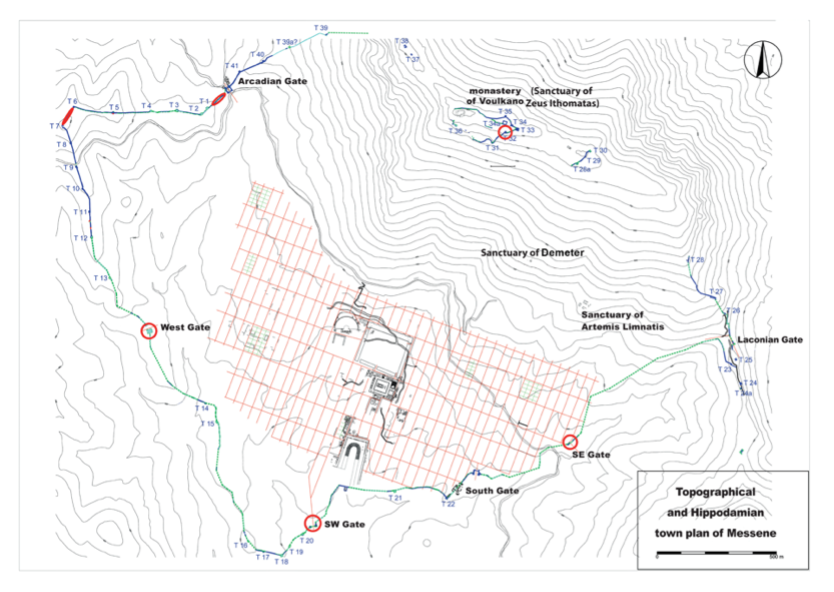
The main building appears to be the Ionic temple, with two Corinthian columns in antis, a deep pronaos and a wide sekos with a pebble floor [fig. 2]. The cult statue stood in the center of the sekos on a plinth. In front of the temple to the east and at a distance of 15 m is a rectangular altar; immediately to the south lie four buildings of different dimensions (A-D). Building A is located directly south-east of the temple and has a long rectangular floor plan. Buildings B and C are set parallel to each other at the southern end of the ridge spur. Excavations in Building B in 2012 and 2013 revealed a podium that runs along the interior with a depth of at least 62-70 cm. Both Building B’s size and its orientation parallel to the Artemis temple hint towards the presence of a second temple within the sanctuary. Building D is located along the south-western part of the temenos, at the edge of the natural plateau on top of a rocky protrusion. It was excavated in the years 2016 and 2018 and possibly is part of a utility structure. Below the plateau of the temenos, and about 15 m to its south, there is a large and long but narrow man-made terrace. Measuring about 40×10 m, it supports architectural remains that probably belong to a fountain. To its east, the natural cavity of the rock can be seen whence water gushed out until as late as the 1980s.
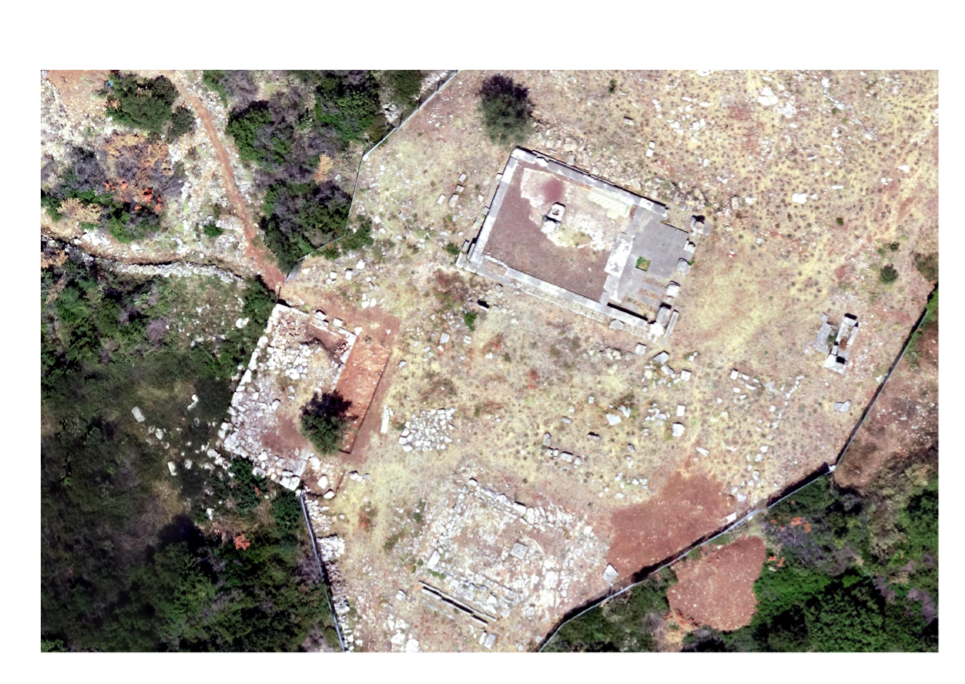
According to an initial study of the finds – mainly the inscriptions mentioned above and the pottery – that came to light in the foundation deposit inside Building D on the west side of the terrace, the sanctuary looks to have been created immediately after the founding of the city by the Theban general Epameinondas in 369 BC. However, the Ionic temple, according to its architectural configuration, probably dates back only to the 2nd century BC. Whether any of the other buildings, such as building B, constitute an earlier temple structure is something that remains to be proven.6
Numerous indeed are the figurines from the sanctuary. Mostly there are preserved those that represent Artemis as a huntress with a torch, in at least six different variants [fig. 3]. The goddess is always depicted standing, wearing a chiton with a large overfold or in a short version, with an animal skin around the torso or, in at least one case, without one; she has a stephane on her head and wears her hair pulled back in a bun or, more rarely, falling free onto the shoulders. In her left hand she carries a tall torch and a phiale in the right. In others, the torch is in the right hand whilst the left hangs by her side.7 A dog is seated by her right foot, with its head turned towards her.
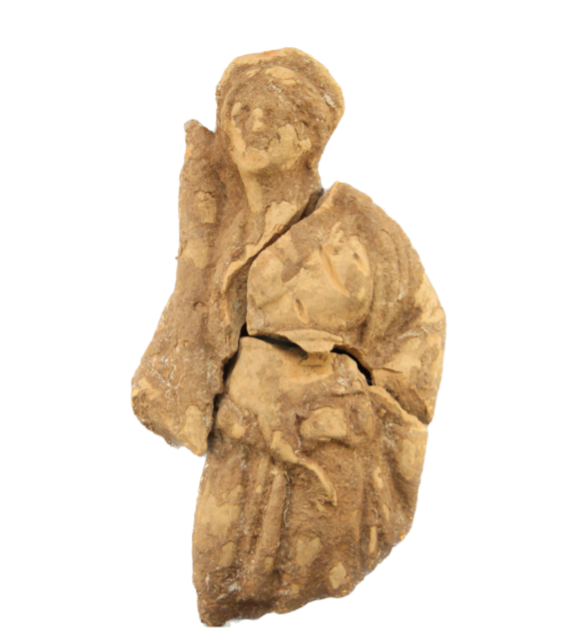
In addition to the above numerous statuettes of Artemis, fragments of marble statuettes of the goddess are also preserved, as well as a smaller bronze one, which depicts the goddess in the above described hunting dress with a short chiton and an animal skin.
The simultaneous presence of iconographic elements such as the torch, the dog at her right and the stephane on the head capture the local type of representation, which differs in details from the types of Artemis as huntress (orLaphria, as the type is often attested in the literature) from other regions. The Messenian Artemis bears similarities with the depiction of the Phrygian Bendis in Attica of the early Hellenistic period but also with Hekate and the Thessalian goddess Enodia.8 The above type of Artemis was favored not only in the sanctuary of Limnatis but also throughout the city of Messene, while figurines of this type were also found in neighboring areas, in Sparta and Elis.9The figurines are apparently modelled after corresponding sculptural types, examples of which were found throughout the city and date from the Hellenistic to Roman times.10 The cult statue of Limnatis which stood in the sekos of the Ionic temple seems to have been of the same type, if we may rely on the fragments recorded by Les Bas, which have since been lost.11
Naturally, other types of figurines were also found in the sanctuary, such as standing female figures with offerings in their hands, “dolls”, heads of female figures of the “Tanagra” types, hydriaphoroi, a male mask, a solitary horse’s leg and a bucranium.
Quite a few bronze finds exist: these are mainly from the 2018 excavation period, coming to light along the northern outer side of building D and probably belong to a dispersed deposit. These comprise several vessel handles (horizontal ones from at least one kylix, swinging handles from bowls) and others belonging to mirrors and boxes, fragments of bronze pyxides and boxes, miniature omphalos phialai and situlai, jewelry such as bracelets and rings, pins, door bosses, flat discs with incised decoration with a probably decorative function and all sorts of clamps and rivets [fig. 4]. Also recovered were fragments of marble pyxides, a stone amulet depicting two figures and a bone dice. All of the above are characteristic finds in the sanctuaries of female deities, mostly Artemis, where the goddess is worshipped mainly by young women during the festivals of transition from childhood to adulthood.12
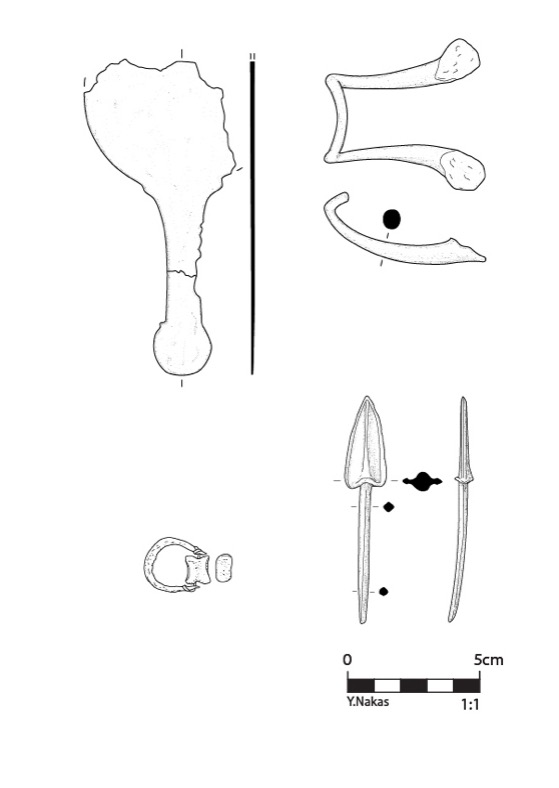
The associated pottery dates from at least the last quarter of the 4th century BC until the later Hellenistic years. To the last quarter of the 4th century BC and the beginning of the 3rd belong the vessels found in the foundation deposit inside Building D. The deposit consists of two Corinthian flat pan roof-tiles revealed next to each other, oriented N-S. The tiles were over a layer of gravel that covered the natural rock on which the building was set. Two gorgoneion-roundels were found close to the tiles, in the very place where they had been originally placed as part of the foundation deposit and inauguration ceremony, along with the head of an Artemis figurine, a kantharos, four juglets, a pyxis, a miniature trefoil oinochoe and a calyx-shaped kanthariskos [fig. 5]. In the fills inside and around the temple, numerous vessels belonging to the category of fine wares were also retrieved, mainly these are open table vessels, such as skyphoi with an inverted rim, plates, phiales, kantharoi, Attic skyphoi, and kraters. Closed vessels are less common, involving aryballoid-lekythoi, and several pyxides. Moreover, parts of large closed and unpainted vessels also appeared, such as basins, table and storage amphoras and water jugs (pitchers).
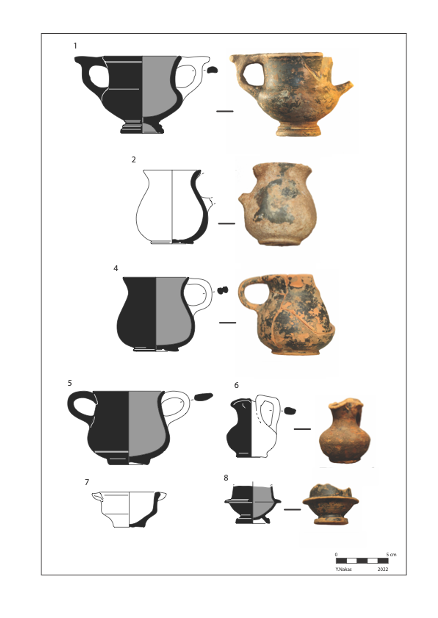
In conclusion, the study of the finds so far – made possible thanks to the fellowship from the Harvard´s Center for Hellenic Studies – confirms the date of the sanctuary after the founding of the city in the 4th century BC and provides strong indications of the character of the worshipped deity.
Bibliography
Bardani, V. 2017. “Επιγραφικές μαρτυρίες για λατρείες στη Μεσσήνη“, In: Themelis P. – Spathi, M. – Psaroudakis, K. (eds), Sanctuaries and Cults of Ancient Messene. From the Pre- Classical to the Byzantine Period, 193–216. Athens.
Brulotte, E. 2002. “Artemis: Her Peloponnesian Abodes and Cults”, In: Hägg R. (ed.), Peloponnesian Sanctuaries and Cults. Proceedings of the Ninth International Symposium at the Swedish Institute at Athens, 11 – 13 June 1994, 179-182. Stockholm.
Cole, S. G. 2004. Landscapes, Gender, and Ritual Space. California.
Feuser, S. – Spathi, M. 2020. “The Sanctuary of Artemis Limnatis in Messene: Natural Setting and Human Action”, In: Haug A. – Muller, A. (eds), Hellenistic Architecture and Human Action: A case of reciprocal influence, 25-39. Leiden.
Kourinou, E. 2000. Σπάρτη. Συμβολή στη μνημειακή τοπογραφία της. Athens.
Le Bas, P. 1844. Voyages et recherches archéologiques en Grèce et on Asie Mineure, RA 1, 426-432.
Mitsopoulou-Leon, V. 2007, „Zu Knaben und Mädchen in Artemisheiligtümern. Die Aussage der Quellen und Votive“, In: E. Simantoni-Bournia, E.-Lemou, A. A.- L. G. Mendoni, L. G. – Kourou, N. (eds), Αμύμονα Έργα. Τιμητικός τόμος για τον καθηγητή Βασίλη Κ. Λαμπρινουδάκη, 189-200. Athens.
Palaiokrassa, L. 1991, Το ιερό της Αρτέμιδος Μουνιχίας. Athens.
Pilz, O. 2011. „The uses of small things and the semiotics of Greek miniature objects”, In: The Gods of Small Things, Pallas 86, 15-30.
Solima, I. 2011. Heiligtümer der Artemis auf der Peloponnes. Heidelberg.
Spathi, M. 2020. “The terracottas from the sanctuary of Artemis Limnatis at Messene”, Les Carnets de l ́ACoSt 20.
Themelis, P. 2008, ‘Ανασκαφή Μεσσήνης’, Praktika, 31-50.
Themelis, P. 2006, ‘Ανασκαφή Μεσσήνης’, Praktika, 31-67.
Themelis, P. 1994. “Artemis Orthia at Messene. The epigraphical and archaeological evidence”, In: Hägg R. (ed.), Ancient Greek Cult Practice from the Epigraphical Evidence 101-122. Stockholm.
Themelis, P. 1991, ‘Ανασκαφή Μεσσήνης’, Praktika, 85-128.
Themelis, P. 1990, ‘Ανασκαφή Μεσσήνης’, Praktika, 56-103.
Themelis, P. 1989, ‘Ανασκαφή Μεσσήνης’, Praktika, 63-122.
Themelis, P. 1988, ‘Ανασκαφή Μεσσήνης’, Praktika, 43-79.
Wannagat, D. – Linnemann, J. 2017. „Ein Versammlungsgebäude im Heiligtum der Artemis Limnatis von Messene“, In: Themelis, P. – Spathi, M. – Psaroudakis, K. (eds.), Sanctuaries and Cults of Ancient Messene. From the Pre-Classical to the Byzantine Period, 29-54. Athens.
1 For the location of its sanctuaries and its relationship with the environment, see generally Cole 2004. Solima 2011. Brulotte 1994.
2 Bardani 2017, 198-199.
3 Her sanctuary in the north-west corner of Asklepieion was one of the first to be established immediately after the foundation of the city, before it was moved in the 2nd century BC into the western wing of the Asklepieion complex, Themelis 1994.
4 Le Bas 1844, 426-432.
5 Themelis 1988, 72-73. Themelis 2006, 55-60. Themelis 2008, 42. Wannagat – Linnemann 2017. Feuser – Spathi 2020.
6 Wannagat – Linnemann (2017) consider it to be a banqueting hall.
7 Spathi 2020, on the variants of the Artemis-type from the sanctuary.
8 LIMC III (1986) 95-97 s.v. Bendis (D. Goceva-D. Popov).
9 Kourinou 2000, 180-184, two examples of a type similar to the Messenian ones but later and examples of a type with quiver and goat from Sparta and the sanctuary of Artemis Kyparissia. Pilz 2011, 106, note 811, from Elis.
10 Fragments from examples of the late 4th and early 3rd centuries BC, Themelis 1991, 90. Themelis 1990, 96-97, pl. 70b, 72, 74. Themelis 1989, 99-105, Roman period, copy of a Late Classical work. Themelis 1988, 68-69, votive relief of the late Hellenistic period.
11 Themelis 2006, 58-59, fig. 4a, b.
12 See for example the finds from the sanctuary of Artemis in Mounichia, Palaiokrassa 1991, 92-95; in Lousoi, Mitsopoulou-Leon 2007.
